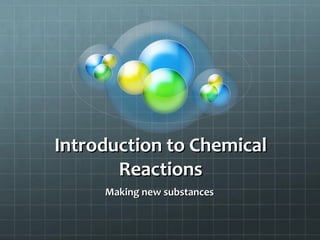Intro to chemical reactions
•Als PPT, PDF herunterladen•
4 gefällt mir•2,573 views
Melden
Teilen
Melden
Teilen

Empfohlen
Weitere ähnliche Inhalte
Was ist angesagt?
Was ist angesagt? (20)
Ähnlich wie Intro to chemical reactions
Ähnlich wie Intro to chemical reactions (20)
CBSE CLASS 10 CHEMISTRY CHAPTER 1 CHEMICAL REACTIONS AND EQUATIONS PART 1 WRI...

CBSE CLASS 10 CHEMISTRY CHAPTER 1 CHEMICAL REACTIONS AND EQUATIONS PART 1 WRI...
Mehr von Bridget.Bradshaw
Mehr von Bridget.Bradshaw (18)
Kürzlich hochgeladen
Kürzlich hochgeladen (20)
Apidays New York 2024 - Accelerating FinTech Innovation by Vasa Krishnan, Fin...

Apidays New York 2024 - Accelerating FinTech Innovation by Vasa Krishnan, Fin...
2024: Domino Containers - The Next Step. News from the Domino Container commu...

2024: Domino Containers - The Next Step. News from the Domino Container commu...
Navigating the Deluge_ Dubai Floods and the Resilience of Dubai International...

Navigating the Deluge_ Dubai Floods and the Resilience of Dubai International...
Rising Above_ Dubai Floods and the Fortitude of Dubai International Airport.pdf

Rising Above_ Dubai Floods and the Fortitude of Dubai International Airport.pdf
Boost Fertility New Invention Ups Success Rates.pdf

Boost Fertility New Invention Ups Success Rates.pdf
Exploring the Future Potential of AI-Enabled Smartphone Processors

Exploring the Future Potential of AI-Enabled Smartphone Processors
Repurposing LNG terminals for Hydrogen Ammonia: Feasibility and Cost Saving

Repurposing LNG terminals for Hydrogen Ammonia: Feasibility and Cost Saving
TrustArc Webinar - Unlock the Power of AI-Driven Data Discovery

TrustArc Webinar - Unlock the Power of AI-Driven Data Discovery
"I see eyes in my soup": How Delivery Hero implemented the safety system for ...

"I see eyes in my soup": How Delivery Hero implemented the safety system for ...
Finding Java's Hidden Performance Traps @ DevoxxUK 2024

Finding Java's Hidden Performance Traps @ DevoxxUK 2024
Biography Of Angeliki Cooney | Senior Vice President Life Sciences | Albany, ...

Biography Of Angeliki Cooney | Senior Vice President Life Sciences | Albany, ...
Intro to chemical reactions
- 1. Introduction to Chemical Reactions Making new substances
- 2. Main Ideas Chemical Reactions are represented by Chemical Equations. Chemical Equations are balanced to show the same number of atoms of each element on each side. The Law of Conservation of Mass says that atoms won’t be created or destroyed in a chemical reaction. That is why you have to balance chemical equations!
- 4. Chemical Reactions are Everywhere Hair Dye Auto Fuel
- 5. How do you know when a chemical reaction takes place? Color Change Precipitate Formation
- 6. How do you know when a chemical reaction takes place? Gas Formation Odor
- 7. How do you know when a chemical reaction takes place? Temperature Change Change in Acidity
- 8. Representing Chemical Reactions Chemists observe chemical reactions and have come up with a way to represent or model what is happening. Making NaCl Solid Sodium combines with Chlorine gas to make solid Sodium Chloride: 2Na (s) + Cl2 (g) 2NaCl
- 9. Chemical Equations are different from Numerical Equations Numerical Equation: 3x + 2y = 47 Chemical Equation 2Na + Cl2 2NaCl ReactantA + Reactant B Product The reactants are used up in forming the product The arrow shows the direction of the reaction
- 10. Symbols used in Chemical Equations Symbol Purpose + Separates more than one reactant or product Separates reactants from products. Indicates direction of reaction (s) Identifies a solid state (aq) Identifies that something is dissolved in water (l) Identifies liquid state (g) Identifies gaseous state
- 11. Law of Conservation of Mass In a chemical reaction, matter is neither created nor destroyed. Atoms won’t change their identity (e.g. a Carbon atom can’t become an Iron atom) This means that you have to have the same number of each type of atom on each side of the chemical equation.
- 12. Balancing Equations After you write a chemical equation you have to balance it to make sure that the same number of atoms of each element are on each side. How would you balance this equation? Li + H2O H2 + LiOH
- 13. Steps to Balancing a Chemical Equation
- 14. Another Example CH4 (methane gas) + O2 CO2 + H2O Reactants Products # of Carbons = 1 # of Carbons = 1 # of Hydrogens = 4 # of Hydrogens = 2 # of Oxygens = 2 # of Oxygens = 3 Total atoms = 7 Total atoms = 6 7 ≠ 6! Where did our atoms go?
- 15. Example Continued Change the Coefficients to make the number of atoms of each element equal Balance the Hydrogens: CH4 + O2 + 2 H2O CO2 + 2 H2O CO2 Balance the Oxygens: CH4 + 2 O2
- 16. Example Continued CH4 + 2 O2 CO2 + 2 H2O Are your coefficients in their simplest ratio? Count your atoms again to check your work: Reactants Products # of Carbons = 1 # of Carbons = 1 # of Hydrogens = 4 # of Hydrogens = 4 # of Oxygens = 4 # of Oxygens = 4 Total atoms = 9 Total atoms = 9
- 17. Try These! C2H6 + O2 CO2 + H2O Fe2O3 + H2SO4 Fe2(SO4)3 + H2O Hint : balance the polyatomic ion first! CaCl2 + AgNO3 AgCl + Ca(NO3)2 Think – Pair - Share
- 18. Review Matter is not destroyed or created Atoms are rearranged in chemical reactions Chemical equations represent chemical reactions You have to have the same number of each type of atom on the left and right hand side of a chemical equation
- 19. WARNING! Don’t mess with the insides of polyatomic ions – put a square around them, or label them as X – treat the WHOLE polyatomic ion as though it were an element! Don’t ever play around with subscripts (those little numbers that tell you how many atoms are in a molecule) e.g. C6H22O11